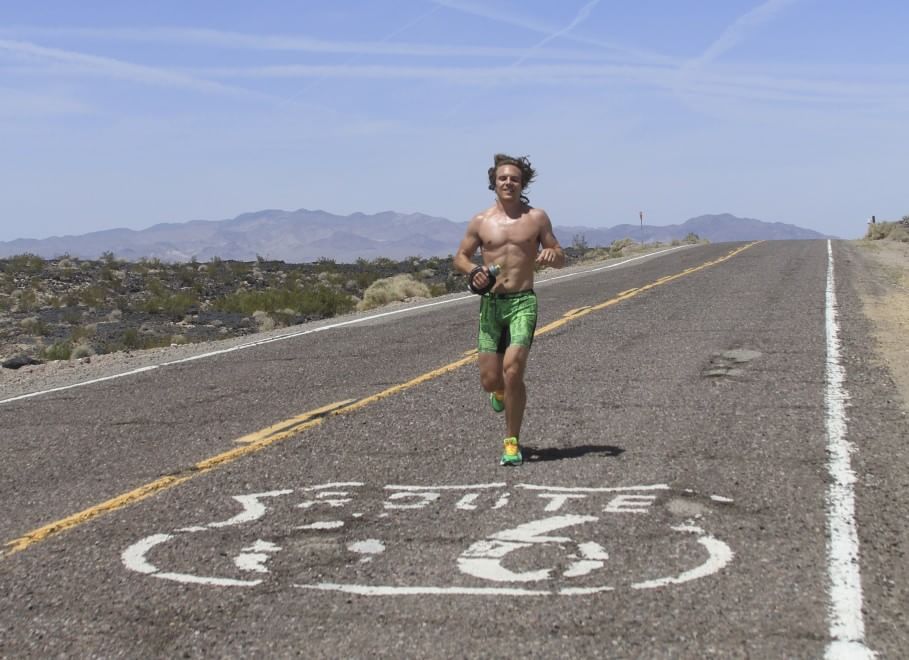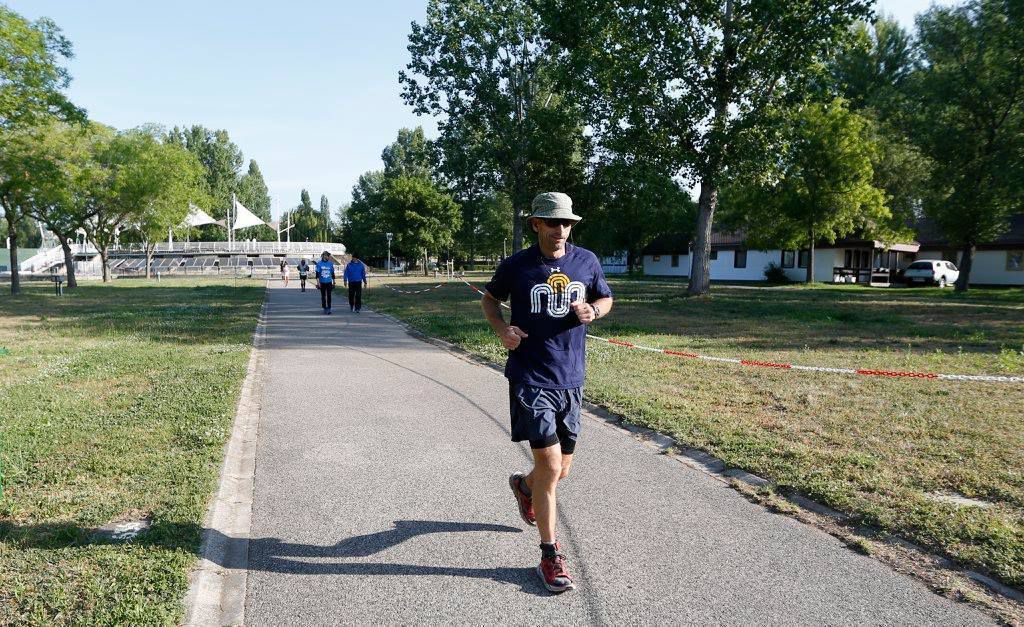Un po' di storia. The classic Six Day race developed in the 1870s, the event has a much longer history. A hundred years earlier the first great British pedestrian or professional distance athlete, Foster Powell, had come to fame with the feat of walking from London to York and back, some 396 miles/637km in less than six days. It was a feat he attempted several times in his career, and was to be copied by later pedestrians.
A later pedestrian, Thomas Savager, walked 404 miles from Hereford via Leaminster to Ludlow in 1789, and in October 1811 another pedestrian called Rimmington reputedly walked 480 miles/772 km in six days in Holt in Dorset. In 1824 the pedestrian Macgowal made a wager to walk 400 miles in 5 days 12 hours. This challenge was probably a response to John Phipps Townsend breaking Foster Powell’s record and taking just 5 days 14 hours and 50 minutes to walk from London to York and return two years earlier.
Thus by the mid nineteenth century the six day event was already recognised, and the possibility of covering 500 miles in that time being considered and debated. However to ignite this into widespread interest and to make the organisation of six day races a commercial success was to take considerable showmanship. An American pedestrian, Edward Payson Weston, was such a showman.
In 1861 Weston undertook to walk from Boston to Washington to attend the inauguration of Abraham Lincoln. Delayed by heavy snow, Weston missed the inauguration, but he had averaged 51 miles a day over the 453 mile course.
Weston’s professional career took off in 1867 when for a $10,000 wager, he completed a walk from Portland, Maine to Chicago, some 1,326 miles in 25 days, not walking on Sundays. The following year he walked 100 miles in 22:19:10 at White Plains, New York, in what was claimed to be a world record.(In fact a faster time had been set some eighty years earlier.)
Through into the early 1870s Weston made a series of well publicised walks against time. 400 miles in five days, was accomplished, and then in 1874 he made a series of attempts to achieve the widely regarded as impossible feat of walking 500 miles in six days,(the maximum period of allowable non-stop activity between Victorian sundays.) He was not without competition.. In August 1874 another American pedestrian called Avery attempted the feat and on failing declared, that no man living could walk the distance in that time. Yet on the 14-19 December, 1874, in one of the major turning points in ultra history, Edward Payson Weston finally achieved that distance,
The publicity generated immediately inspired others to become would-be pedestrians. The greatest of these was Daniel O’Leary, an Irish door to door book salesman, who quickly established his ultra walking credentials. A challenge match with Weston was arranged in Chicago. The Irishman covered 503.3 miles, some fifty miles ahead of Weston’s final distance. The latter had played a waiting game, expecting O’Leary to collapse.
In 1876 and 1877 Weston and O’Leary travelled to Britain, where Weston had outclassed the native walkers the previous year. Despite being defeated by a couple of British walkers in shorter events, O’Leary again emerged the winner in a two man match event against Weston. 70,000 people came to watch the race and Sir John Astley, the promoter, was so taken with the event that he decided to promote a whole series of such races for the Astley Belt, for “the Long Distance Challenge Championships of the World”. Because of disputes about the fairness of Weston’s walking action, the events were `go-as-you-please’- open to both walkers or runners. Weston did not contest the first Astley Belt race and O’Leary won yet again with a new world best of 520.25 miles with Britain’s Harry Vaughan in second.
O’Leary returned to the States and defended the belt against the overly optimistic John Hughes who offered him little opposition. However in 1879 O’Leary had to defend his title against a much tougher opponent, British newcomer Charles Rowell. The latter wore down his opponents with his relentless dog-trot and emerged the winner with 500 miles, and the remarkable sum of $20,398 – this at a time when the average working man’s annual salary was around $500.
Weston wasn’t finished with the six day event. He took up running, and using his wife’s inheritance for his $500 entry fee, he entered the fourth Astley belt race to be held at the Agricultural Hall, Islington, London. Rowell had injured his heel and withdrew from the event. After a tough battle over the first three days against the Briton Henry `Blower’ Brown, Weston emerged the stronger. At that stage Astley bet him he could not complete 550 miles in the six days; he did so, setting a new world best for the event.
By the fifth Astley Belt race, a completely professional set up was in place. All the runners had managers; the price of admission to spectators was one dollar and gate receipts were carefully monitored by the performers. Rowell set off strongly and had a commanding lead by four days into the race, however at that point he was taken ill and took eleven hours off the track. Samuel Merritt (USA) closed on him but the Englishman recovered enough to walk for most of the sixth day, ensuring that he won with 530 miles to Merritt’s 515.
The Astley Belt event was not the only such competition. O’Leary had sponsored a belt competition in his own name to develop new talent, and there were in fact a wealth of multi-day races spread across the English speaking world. Although concentrated on the Eastern seaboard in the USA, there were pedestrian events across America, even in the gold fields of California.
The first all woman six day match seems to have taken place between Mary Marshall of Chicago and Bertha Von Hillern in January 1876, and was won by Marshall with 234 miles. A rematch was held in New York in November in which Hillern turned the tables and won with 323.5 miles, when Marshall had trouble with her feet. When the British pedestrienne Ada Anderson came over to States it became fashionable to attend such events. Americans Bertha Von Berg and Amy Howard forced the record upwards.
The pedestriennes’ rewards were not as great as the men’s, even in the major venues, despite the newspaper coverage their races generated. In May 1880 a World Championship race for a gold, silver and diamond championship belt was held in San Francisco, with many of the top women performers taking part. Amy Howard of New York set new world bests for 24 hours of 95 miles, and 410 miles 251 yards for six days beating Sara Tobias, who also covered over 400 miles. However the winner received just $1000, and Tobias $750.
These major championship events were just the tip of the iceberg. Variations on the 6 day race were held in cities across Britain and the East Coast of the United States, and included the popular 6 x 12 hours and 6 x 10 hour events, designed to maximise the pedestrian activity during the period when most spectators would be present Some enterprising promoters had a travelling circus, complete with tent, in which pedestrians would “compete”, showing off their paces to new audiences intrigued by the novelty of these endurance events.
Even in Australia such events were contested with William Edwards winning a six-day tournament over 432 miles around Melbourne in 1882.
The six day record continued to creep ever upwards under the pressure of the sustained international competition. Frank Hart ,the professional name of Fred Hichborn, perhaps the first major African-American ultrarunner, regained the six day record for the States in 1880, after Blower Brown had taken it in mid-1879, and in 1881 his fellow Americans John Hughes, Robert Vint and finally Patrick Fitzgerald edged the record ever closer to 600 miles. In February 1882 Rowell returned to the scene in earnest. At the Madison Square Gardens, New York in a blitz start he set new world bests for 100 miles (13:26), 24 Hours (150 miles) and 48 hours (258 miles/415km), reaching 300 miles in 58:17:06 (a record which still stands today despite the efforts of Yiannis Kouros!) During a rest period Rowell inadvertently swallowed some vinegar which eventually forced his retirement, and it was left to his fellow countryman, George Hazael, to be the first man to cover 600 miles/965km in six days.
Rowell was never to dominate the six day event again. In an epic struggle in 1884 he was defeated by American Pat Fitzgerald when the latter set a new world best of 610 miles/981km, but by now the pedestrian era was on the wane. In 1888 a new American star, James Albert became the first man to run over a 1000km in a six day event with 621.75 miles, and in November the Briton, George Littlewood travelled to New York for an attempt on Albert’s record. After a four day struggle with Daniel Herty, a consistent US performer, the Briton broke the world best with 623.75 miles/1003km. Apparently he could have gone further, but did not want to make his task too difficult next time.
There was to be no next time for Littlewood. The interest in the six day event had declined in the face of competition from the more energetic and exciting cycling events.
The great public attention given to professional ultrarunning had inspired the amateur long distance runners on both sides of the Atlantic. In February 1882 the British runner, James Saunders achieved a new 24 hour amateur best of 120 miles 275 yards/193.3km at the American Institute Ring in New York City, setting a 100 mile mark en route of 17:36:14 – strangely enough there appears to have been $100 prize money! Despite this, Saunder’s mark is credited as the amateur world record in contemporary recordbooks. A year later, Peter Golden set an American amateur 50 mile best of 7:29:47 on the track at Williamsburgh.
Golden was to go on to set a `world record’ of 352.5 miles for six days as a professional in 1899 on a minute twenty laps to the mile track – a mere 88 yards in circumference! By then the golden age of the event was over. Pat Cavanaugh, an Irish American was the most successful runner during the declining years with 532.125 miles/856km in 1902, also setting a two man relay world best with Peter Hagelman of 770.5 miles/1240km the previous year. But by 1903 the event was gradually petering out.
Chinese-American Don Choi’s pioneer work in multi-day races in 1979 and 1980 in California revived a whole new branch of the sport. Without his work, there would probably be no present day 48 hour or 6 Day races. Choi then Park Barner edged modern 6 day record well over 400 miles, but the former glories of the 6 day event began to emerge when Briton Mike Newton became the first man to covered 500 miles /800km in a modern 6 days at Nottingham in November 1981. Tom O’Reilly took the record passed 900km the following year at the same venue.
Women soon tackled the event led by the pioneer Marcy Schwam who covered 384 miles/617km in 1981. It was Britain’s Eleanor Adams who drove the track record upwards, eventually reaching 866km/538 miles.
1984 saw George Littlewood’s 6 day mark beaten by Yiannis Kouros .[635 mile/1022km] This performance had a major impact on the event. Without the mystic of the hundred year old record, and the world best now beyond the reach of many, interest in the event subsided again.
In the late 1980s and early 1990s there was again a revival in the event when first Australian Bryan Smith, and then James Zarei, the Iranian born British based runner, exceeded 1000km/ 621.3 miles on the track. It was in this period that New Zealander Sandra Barwick set the current women’s track best of 883.6km/549 miles. In 1992 the La Rochelle indoor race saw Frenchman Jean-Gilles Boussiquet set an absolute best for the event, covering 1030km/640 miles, with fellow countryman Gilbert Mainix, also running over 1000km in second place. After this upsurge in performance, once again it was some years before such levels were to be matched.
Meantime on the road, the American based British/Australian runner , Catherine Dipali Cunningham set new world female marks for 6 days, 811km/503 miles in 1990 and 820km/510 miles in 2001 in New York
In 2005 Yiannis Kouros set a new absolute best on the track at Colac, running 1036km644 miles, and since then the German Wolfgang Schwerk has been dominant, running 1010km/627 miles at Erkrath in 2007. William Sichel has emerged as the strongest British protagonist in recent years.
It is difficult to judge just how good the current 6 Day records are. The marks set in the nineteenth century were very tough in relation to other events, primarily because of the levels of prize money on offer..
A comparison with the mile event, which was high profile then and has remained so over the decades since, is possibly useful. The world mile record has progressed by some 13% over the past 120 years. Similar progress in 6 Day performances would result in a record of over 1126km/700 miles. The 6 Day has not had the same level of competitive pressure and certainly not the same level of prize money on offer in the 20th and 21st centuries as the mile event, but if such comparable prize money was on offer, then perhaps such a distance could be expected.
The six day event continues to be a focus for multi-day runners all over the world, but there are relatively few such races, due to the cost and commitment needed to organise such a prolonged race. Consequently the number of six day runners is not large. The race continues to have a unique place in the sport of Ultrarunning, and for many remains a fascinating and formidable challenge.
Andy Milroy
 The Association Of Greek Dayrunners and the newly established FAOS Mountaineering Club launch the 1st Authentic Fidippides’s Run Athens – Sparta – Athens (490K), which will take place on November 21-25, 2015.
The Association Of Greek Dayrunners and the newly established FAOS Mountaineering Club launch the 1st Authentic Fidippides’s Run Athens – Sparta – Athens (490K), which will take place on November 21-25, 2015.
/http%3A%2F%2Fwww.runningnews.gr%2Flib_photos%2Fnews14%2F2014_05_30_Feidipidios.jpg)



/image%2F1400173%2F20151122%2Fob_86610a_ob-349bad-phidippides.jpg)
/image%2F1400173%2F20151122%2Fob_fb6d67_ob-b67ae7-statue-of-pheidippides-along.jpg)
/image%2F1400173%2F20151122%2Fob_d8478d_ob-3c066d-image.jpg)


/image%2F1400173%2F20151008%2Fob_a397c8_ob-98371a-2012-start-3100.jpg)
/image%2F1400173%2F20151008%2Fob_15a1ca_ob-04791b-jowan-3.jpg)
/image%2F1400173%2F20151008%2Fob_27282b_ob-2e1515-start1.jpg)
/image%2F1400173%2F20151008%2Fob_5bac83_ob-2a5d46-start-3100-mile.jpg)
/image%2F1400173%2F20151008%2Fob_48df6d_ob-a8fecd-wide-vasu1.jpg)
/image%2F1400173%2F20151008%2Fob_52aa7a_ob-562024-3100-mile-race-2012.jpg)
/image%2F1400173%2F20151008%2Fob_682ac2_ob-e9d773-jowangauthier.jpg)
/image%2F1400173%2F20151008%2Fob_df21c4_ob-012add-grahak.JPG)
/image%2F1400173%2F20151008%2Fob_693586_ob-76661b-group-shot-550x353.jpg)
/http%3A%2F%2F3100.srichinmoyraces.org%2Ffiles%2Fstyles%2Fbanner%2Fpublic%2F3100%2Fevents%2Fmain-3100%2Fbanner%2F3100start2015.jpg%3Fitok%3DrSAlE2kU)
/image%2F1400173%2F20150927%2Fob_cb2efb_ob-ebde30-reus-spartathlon-2015.jpg)
/image%2F1400173%2F20150927%2Fob_5a87dd_ob-f6aad1-sparta-spartathlon-2015.jpg)
/http%3A%2F%2Fscontent.xx.fbcdn.net%2Fhphotos-xpt1%2Fv%2Ft1.0-9%2Fs720x720%2F12043035_970525836341416_2169201323589171587_n.jpg%3Foh%3Da977f07ed0ecf9e4989d7d7c3031e711%26oe%3D568EA2CD)
/http%3A%2F%2Fmagazine.podisti.it%2F2013%2Fimages%2Fstories%2Faa_foto%2Fa-GARE_da_GENNAIO_2015%2FVarie-2015%2FSparta-Spartathlon-2015.jpg)








/http%3A%2F%2Fupload.wikimedia.org%2Fwikipedia%2Fcommons%2Fthumb%2F9%2F95%2FTomHanksForrestGump94.jpg%2F150px-TomHanksForrestGump94.jpg)

/image%2F1400173%2F20150512%2Fob_e1081f_ob-6467e5-08.jpg)
/image%2F1400173%2F20150512%2Fob_b9d9ed_ob-602877-09.jpg)
/image%2F1400173%2F20150512%2Fob_73810f_ob-c3d46b-091.jpg)
/image%2F1400173%2F20150512%2Fob_7fa255_ob-ba81c6-092.jpg)
/image%2F1400173%2F20150512%2Fob_a23b62_ob-bea2ff-093.jpg)
/image%2F1400173%2F20150512%2Fob_9f14a9_ob-fe9a57-094.jpg)
/image%2F1400173%2F20150512%2Fob_874eb1_ob-933163-095.jpg)
/image%2F1400173%2F20150512%2Fob_7099e3_ob-4d7571-097.jpg)
/image%2F1400173%2F20150512%2Fob_6ef674_ob-c72329-098.jpg)
/image%2F1400173%2F20150512%2Fob_db6a52_ob-18e930-099.jpg)
/image%2F1400173%2F20150512%2Fob_9d9c99_ob-88bcc3-0991.jpg)
/image%2F1400173%2F20150512%2Fob_917fd2_ob-1d2f8a-0992.jpg)
/image%2F1400173%2F20150512%2Fob_a08654_ob-28abc8-0993.jpg)
/image%2F1400173%2F20150512%2Fob_def893_ob-fd2b01-0995.jpg)
/image%2F1400173%2F20150512%2Fob_b7afb2_ob-6bddd7-0994.jpg)
/image%2F1400173%2F20150512%2Fob_686d6e_ob-fb25de-0996.jpg)
/image%2F1400173%2F20150512%2Fob_3e6bb9_ob-9a879f-0997.jpg)
/image%2F1400173%2F20150512%2Fob_e76883_ob-11ac69-0999.jpg)
/image%2F1400173%2F20150512%2Fob_7c78df_ob-a433b8-0998.jpg)
/image%2F1400173%2F20150512%2Fob_6520dc_ob-20dd75-09992.jpg)
/image%2F1400173%2F20150512%2Fob_0ad9a9_ob-4e3bbc-09993.jpg)
/http%3A%2F%2Fwww.emusport.hu%2Fsites%2Fdefault%2Ffiles%2Fkepek_hirekhez%2Flogo---cn---icc---carbon-neutral-race_w1600_ii_ok_CutoutCutout2.png)
/image%2F1400173%2F20150510%2Fob_592550_ob-111396-05-sonia-lutterotti.jpg)
/image%2F1400173%2F20150510%2Fob_592550_ob-111396-05-sonia-lutterotti.jpg)
/image%2F1400173%2F20150510%2Fob_9e665b_ob-58456c-06.jpg)
/image%2F1400173%2F20150510%2Fob_7457a6_ob-cf64c1-03.jpg)
/image%2F1400173%2F20150510%2Fob_ee09e0_ob-60dc96-02.jpg)
/image%2F1400173%2F20150510%2Fob_8c341d_ob-e0cc07-01.jpg)
/image%2F1400173%2F20150510%2Fob_8b31bb_ob-a39017-04.jpg)
/image%2F1400173%2F20150510%2Fob_791bba_ob-1c05f7-07.jpg)
/image%2F1400173%2F20150510%2Fob_523a4c_ob-a193cc-08-andreas-michalitz.jpg)
/http%3A%2F%2Ffbcdn-profile-a.akamaihd.net%2Fhprofile-ak-prn2%2Fv%2Ft1.0-1%2Fc18.12.145.145%2F943686_407954602645053_1738607138_n.jpg%3Foh%3Dded8bb755f99aef6f1c2ab9982f62b59%26oe%3D55D47894%26__gda__%3D1439823510_8f38da450266b57532d517dc98bc99a9)
/http%3A%2F%2Femusport.hu%2Fsites%2Fdefault%2Ffiles%2Fbanner%2Fszponzor.gif)
/image%2F1400173%2F20150509%2Fob_11dd30_ob-46e76d-02.jpg)
/image%2F1400173%2F20150509%2Fob_a40fc9_ob-73007f-04.jpg)
/image%2F1400173%2F20150509%2Fob_9d485a_ob-5dc99d-05.jpg)
/image%2F1400173%2F20150509%2Fob_ee5378_ob-016bb3-06.jpg)
/image%2F1400173%2F20150509%2Fob_d56fed_ob-d959b6-07.jpg)






 Perchè ho dato alla mia pagina questo titolo?
Perchè ho dato alla mia pagina questo titolo? L'idea motrice di questo nuovo web site è scaturita da una pagina Facebook che ho
creato, con titolo simile ("
L'idea motrice di questo nuovo web site è scaturita da una pagina Facebook che ho
creato, con titolo simile ("










